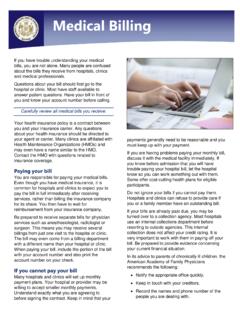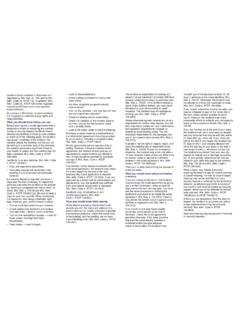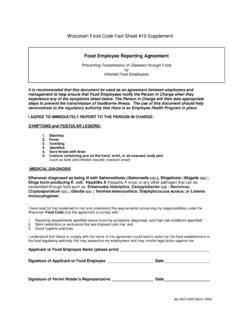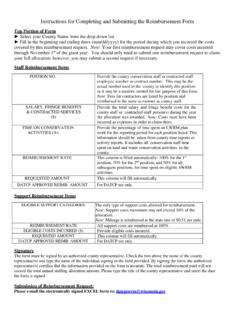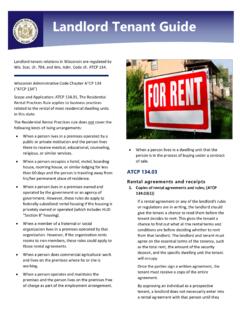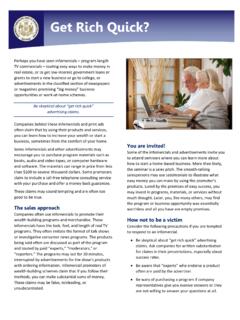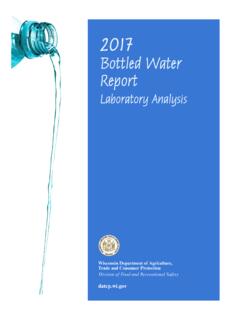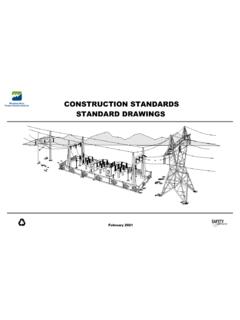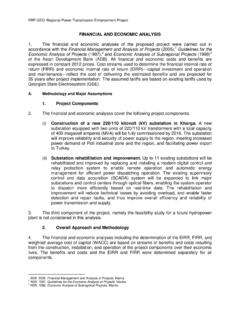Transcription of RIGHTS-OF-WAY AND EASEMENTS
1 Introduction The Public Service Commission of Wisconsin (PSCW) offers this overview to landowners who must negotiate easement contracts with utilities for new electric transmission lines or sales of land for substations . It explains the utility easement process so that the negotiations might have a balanced foundation for reaching agreement. The Commission understands that there are concerns among landowners about the eminent domain process (condemnation.) The procedures of eminent domain are addressed in this overview, but a more complete discussion is contained in a publication from the Wisconsin State Energy Office1 entitled, The Rights of Landowners under Wisconsin s Eminent Domain Law.
2 Because easement agreements are private contracts, the PSCW does not participate in the negotiations between utilities and landowners. The processes for negotiation and condemnation are covered by the laws in Chapter 32 of the Wisconsin Statutes. Several appropriate citations from Chapter 32 are identified in this overview. This overview explains what a transmission right-of-way is and how a utility normally obtains the RIGHTS-OF-WAY it needs to build and protect its facilities. It also explains the relationship between initial contract negotiations and the eminent domain process.
3 Finally, it discusses some concerns about landowner rights and utility easement contracts. If easement negotiations for an easement between a utility and a landowner fail and the condemnation process begins, the landowner should review the R ig hts of Landowners state publication. Electric Transmission line Right-of-Way An electric transmission line right-of-way (ROW) is a strip of land that an electric utility uses to construct, maintain, or repair a large power line . The easement for the ROW allows the utility to keep the line ROW clear of vegetation, buildings, and other structures that could interfere with line 1 The Wisconsin State Energy Office is part of the Department of Administration.
4 The eminent domain publication is currently located on the state website under Relocation Assistance Program, 1 operation. If the utility needs access roads to get to the power line ROW, it also obtains EASEMENTS for those access roads. A transmission line ROW is wider than a ROW for a smaller distribution line that serves homes and businesses directly. Transmission lines may operate at several hundred thousand volts and can serve several hundred thousand customers.
5 Distribution lines operate at several thousand volts and can serve a few thousand customers. A service connection to a home operates at a few hundred volts. A transmission line is usually centered in the ROW. The structures (usually poles and cross arms) keep the wires away from the ground, other objects, and each other. Structure height, type, span length (distance between structures), and ROW width are interrelated. If landowners wish to have fewer transmission structures installed on their land, they might ask if a longer span length is possible.
6 To increase the span length, the utility might need to increase the structure height. If the span length and height are greatly increased, a wider ROW is sometimes needed. Attachment of the distribution wires (distribution underbuild) to the structures limits the transmission span length to maintain safe clearances below the distribution line . How a Utility Obtains a ROW A utility obtains a ROW for an electric transmission line through the purchase of an easement (purchasing rights to the land) or fee title ownership (purchasing the land).
7 EASEMENTS The most common arrangement for a utility to obtain land rights is an easement. A utility real estate agent contacts a landowner to purchase an easement for a specific parcel or strip of land that is to be used for the power line , and negotiations begin. An easement contract between the utility and the landowner is a legal restriction on land use that allows the utility to build, maintain, and protect the power line and allows the landowner to retain general ownership and control of the land. In addition, the landowner retains the obligation to pay taxes on the parcel.
8 The landowner sells the easement to the utility for a negotiated amount of money, generally paid in one lump sum. The contract specifies restrictions on both the utility s and the landowner s use of the land and specifies the rights of the utility. It is binding upon the utility, the landowner, and any future owners of the land until the contract is dissolved. Sometimes, a new line needs to be installed in place of an older line that is in poor condition. If the existing ROW is not appropriate for the new line , a new ROW must be obtained through a new easement.
9 Newer transmission easement agreements must specify the: type, height limits, and number of new structures; line voltage; ROW width. If the existing ROW and structures are still appropriate but the old easement can be improved in other ways, the utility might offer to renegotiate the easement contract. For example, some older easement contracts have wording that is difficult to interpret or a legal description that refers to an entire 40-acre parcel for the ROW when only a 60-foot-wide strip is needed. The utility may ask to renegotiate a contract when rebuilding an old line on existing ROW in order to clarify its relationship with the affected landowner.
10 2 Fee Simple Purchases Another arrangement for obtaining new power line ROWs is for the utility to purchase fee simple ownership. In this arrangement, a landowner sells the strip of land to the utility outright. The utility owns the ROW in fee simple. In this situation, the landowner gives up ownership of the land along with all the rights and responsibilities that ownership entails. This is a common arrangement for new substations , but it is used only occasionally for power line ROWs. Substation Lands Transmission substations vary in size because of the different numbers of lines and different size lines and transformers in each one.
